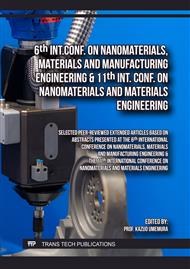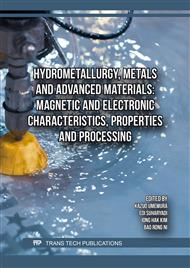[1]
George, E.P., D. Raabe, and R.O. Ritchie, High-entropy alloys. Nature reviews materials, 2019. 4(8): pp.515-534.
DOI: 10.1038/s41578-019-0121-4
Google Scholar
[2]
Murty, B.S., et al., High-entropy alloys. 2019: Elsevier.
Google Scholar
[3]
Li, W., et al., Mechanical behavior of high-entropy alloys. Progress in Materials Science, 2021. 118: p.100777.
Google Scholar
[4]
Zhang, Y., et al., Microstructures and properties of high-entropy alloys. Progress in materials science, 2014. 61: pp.1-93.
Google Scholar
[5]
Karlsdottir, S.N., et al., Corrosion behavior of AlCrFeNiMn high entropy alloy in a geothermal environment. Geothermics, 2019. 81: pp.32-38.
DOI: 10.1016/j.geothermics.2019.04.006
Google Scholar
[6]
Li, X., et al., Microstructures and properties of AlCrFeNiMnx high-entropy alloy coatings fabricated by laser cladding on a copper substrate. Journal of Alloys and Compounds, 2022. 926: p.166778.
DOI: 10.1016/j.jallcom.2022.166778
Google Scholar
[7]
Popescu, G., et al. Mechanically alloyed high entropy composite. in IOP Conference Series: Materials Science and Engineering. 2016. IOP Publishing.
DOI: 10.1088/1757-899x/145/7/072007
Google Scholar
[8]
Moghaddam, A.O., et al., Additive manufacturing of high entropy alloys: A practical review. Journal of Materials Science & Technology, 2021. 77: pp.131-162.
Google Scholar
[9]
Chao, Q., et al., Direct laser deposition cladding of AlxCoCrFeNi high entropy alloys on a high-temperature stainless steel. Surface and Coatings Technology, 2017. 332: pp.440-451.
DOI: 10.1016/j.surfcoat.2017.09.072
Google Scholar
[10]
Torralba, J.M. and M. Campos, High entropy alloys manufactured by additive manufacturing. Metals, 2020. 10(5): p.639.
DOI: 10.3390/met10050639
Google Scholar
[11]
Zhang, M., et al., Microstructure and elevated temperature wear behavior of laser-cladded AlCrFeMnNi high-entropy alloy coating. Optics & Laser Technology, 2022. 149: p.107845.
DOI: 10.1016/j.optlastec.2022.107845
Google Scholar
[12]
Tao, Y., et al., Improvement of thermal shock resistance and hot mechanical properties by FCC/BCC/B2 multiphase strengthened microstructure in laser cladded high-entropy alloy coatings. Surface and Coatings Technology, 2023. 472: p.129919.
DOI: 10.1016/j.surfcoat.2023.129919
Google Scholar
[13]
Xiang, S., et al., Effects of process parameters on microstructures and tensile properties of laser melting deposited CrMnFeCoNi high entropy alloys. Materials Science and Engineering: A, 2019. 743: pp.412-417.
DOI: 10.1016/j.msea.2018.11.110
Google Scholar
[14]
Wei, X., et al., Effect of phase transformation on mechanical properties of Al16. 80Co20. 74Cr20. 49Fe21. 28Ni20. 70 high entropy alloy coatings processed by laser cladding. Journal of Alloys and Compounds, 2021. 862: p.158563.
DOI: 10.1016/j.jallcom.2020.158563
Google Scholar
[15]
Malatji, N., et al., Tribological and corrosion properties of laser additive manufactured AlCrFeNiCu high entropy alloy. Materials Today: Proceedings, 2020. 28: pp.944-948.
DOI: 10.1016/j.matpr.2019.12.330
Google Scholar
[16]
Feng, X., et al., Effect of Al content on wear and corrosion resistance of Ni-based alloy coatings by laser cladding. Surface and Coatings Technology, 2021. 412: p.126976.
DOI: 10.1016/j.surfcoat.2021.126976
Google Scholar
[17]
Kanyane, L.R., et al., Microstructural evolution and corrosion properties of laser clad Ti-Ni on titanium alloy (Ti6Al4V). Procedia Manufacturing, 2019. 35: pp.1267-1272.
DOI: 10.1016/j.promfg.2019.06.086
Google Scholar
[18]
Chen, J., X. Wang, and Y. Pan. Influence of laser power and scan speed on the microstructure and properties of GH4169 alloy prepared by selective laser melting. in IOP Conference Series: Materials Science and Engineering. 2019. IOP Publishing.
DOI: 10.1088/1757-899x/688/3/033064
Google Scholar
[19]
Hao, L., et al., Effect of scanning speed and laser power on formability, microstructure, and quality of 316L stainless steel prepared by selective laser melting. Journal of Materials Research and Technology, 2023. 25: pp.3189-3199.
DOI: 10.1016/j.jmrt.2023.06.144
Google Scholar
[20]
Zhang, C., et al., Cracking mechanism and mechanical properties of selective laser melted CoCrFeMnNi high entropy alloy using different scanning strategies. Materials Science and Engineering: A, 2020. 789: p.139672.
DOI: 10.1016/j.msea.2020.139672
Google Scholar
[21]
Mahamood, R.M., E.T. Akinlabi, and S. Akinlabi, Laser power and scanning speed influence on the mechanical property of laser metal deposited titanium-alloy. Lasers in Manufacturing and Materials Processing, 2015. 2: pp.43-55.
DOI: 10.1007/s40516-014-0003-y
Google Scholar



